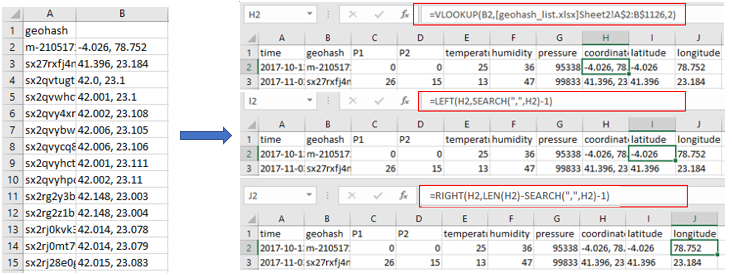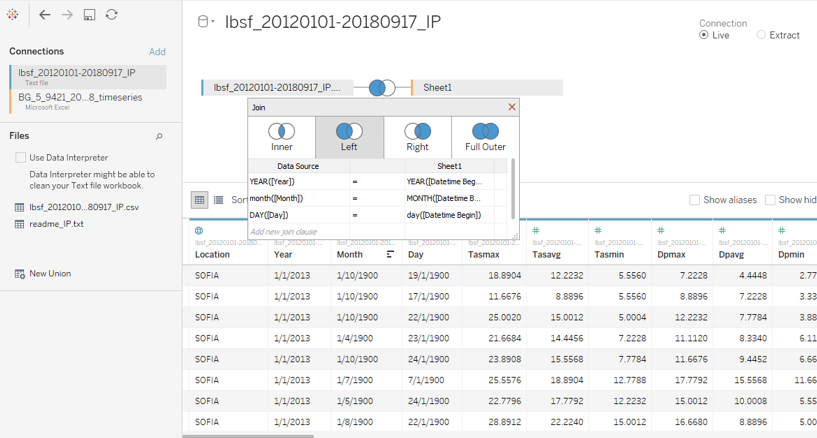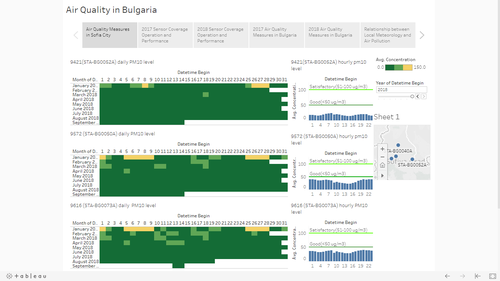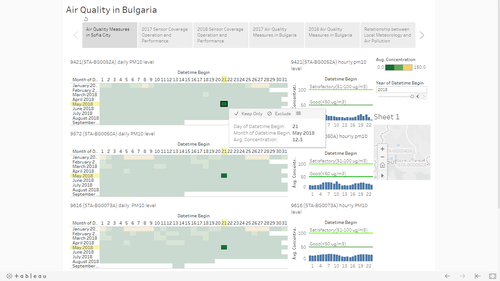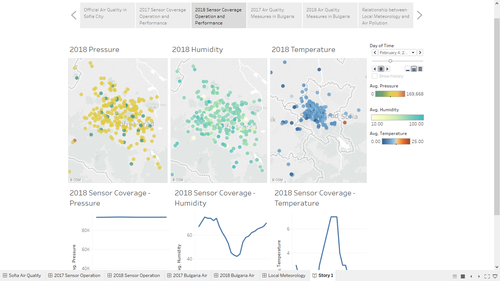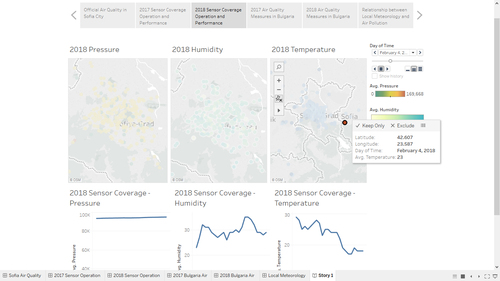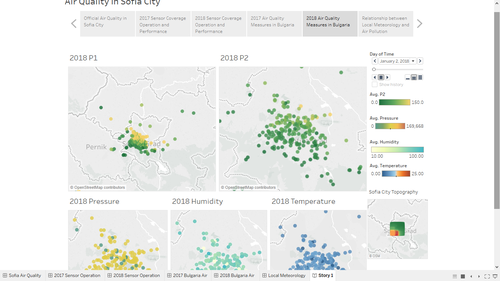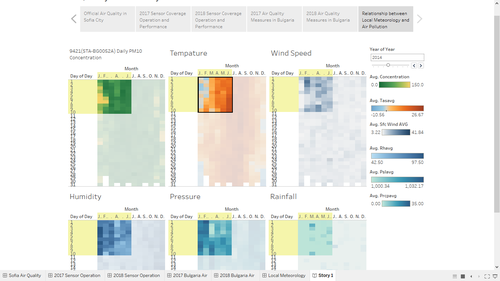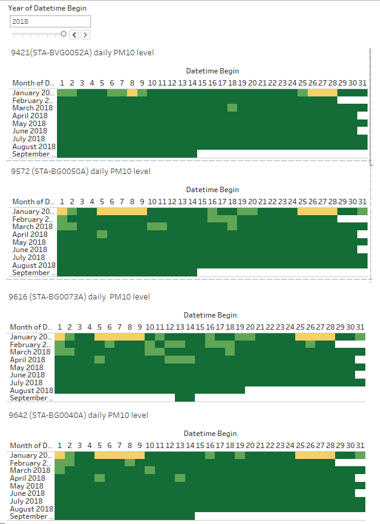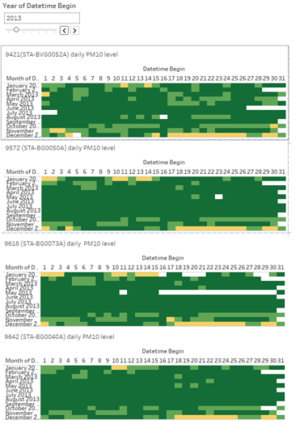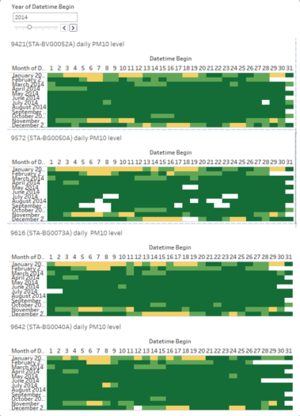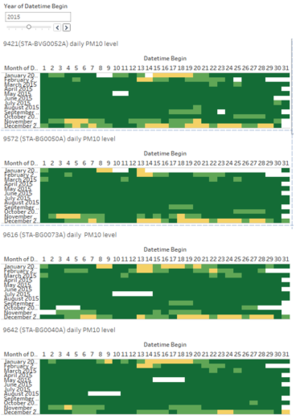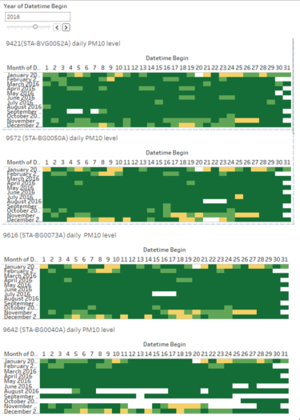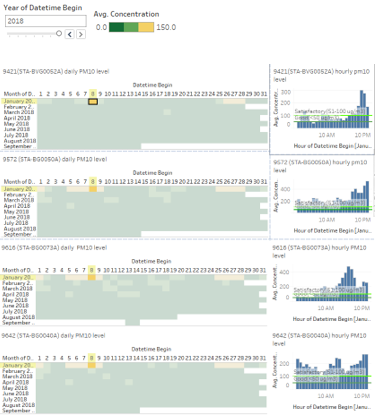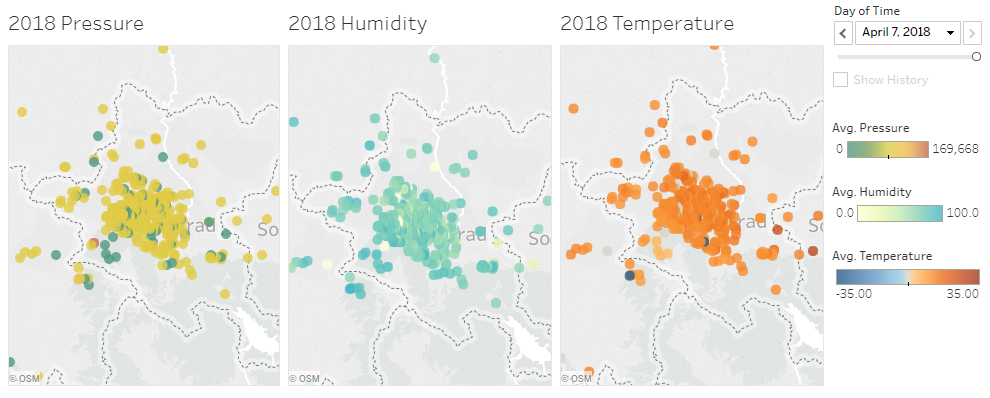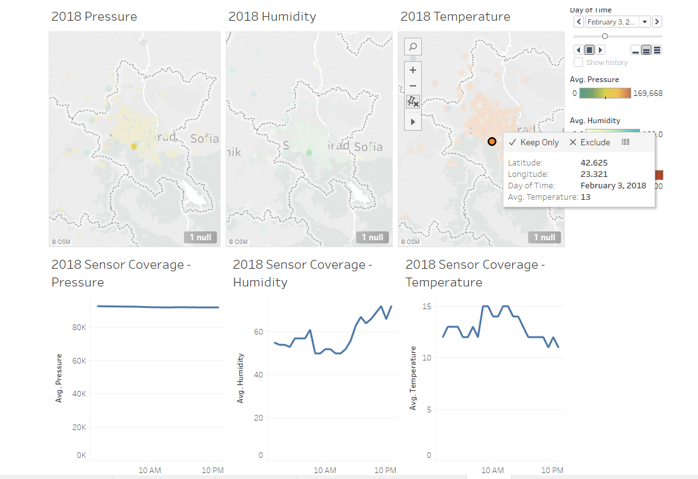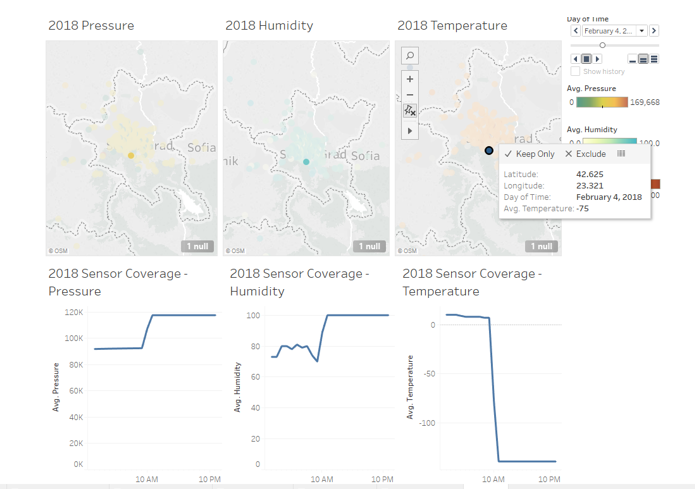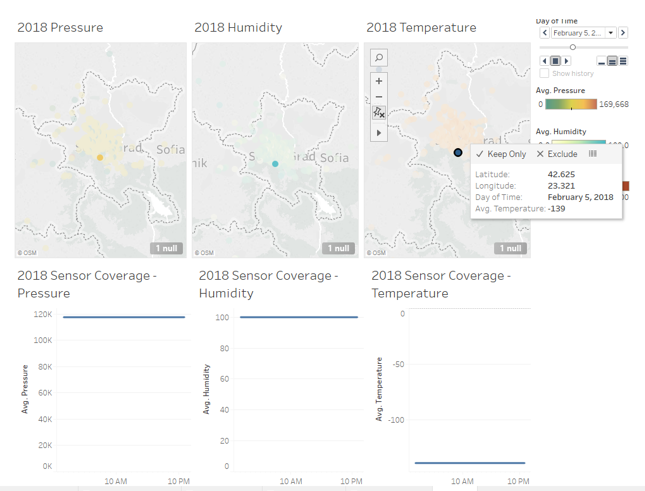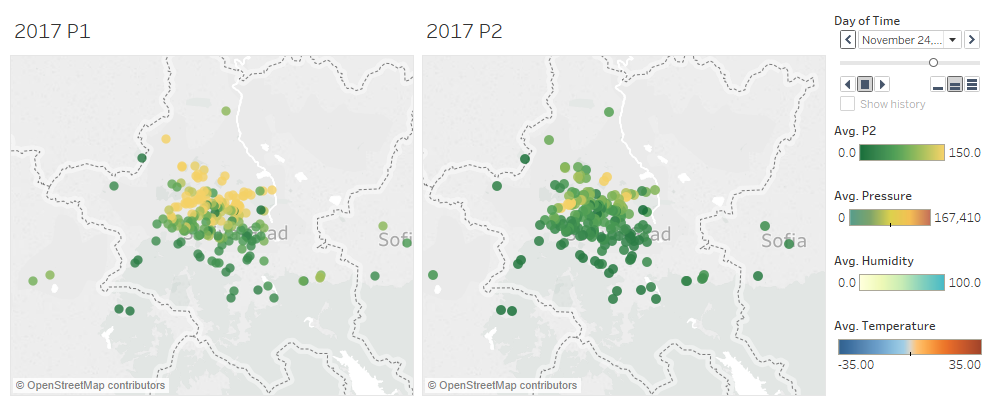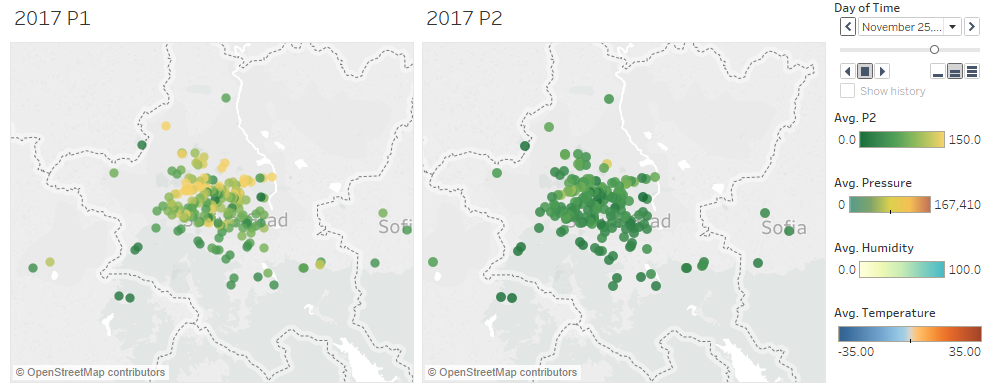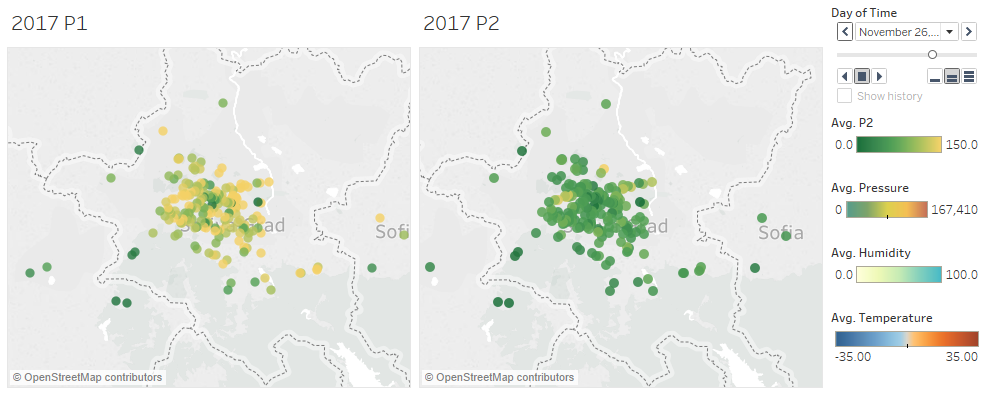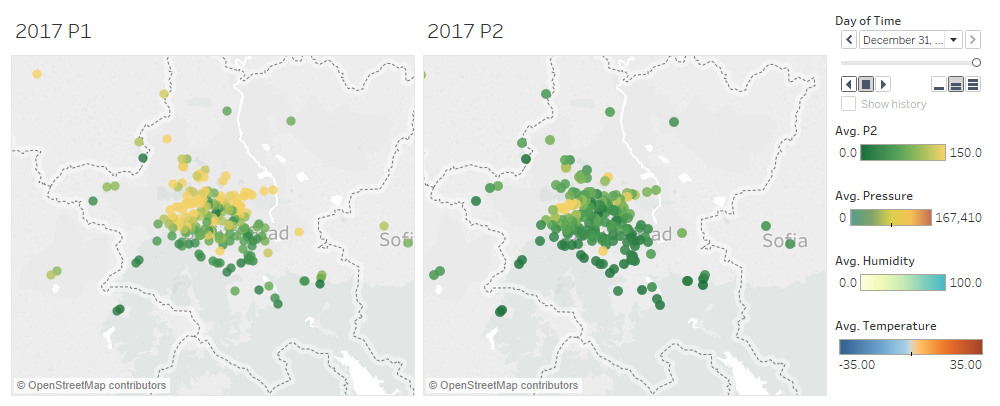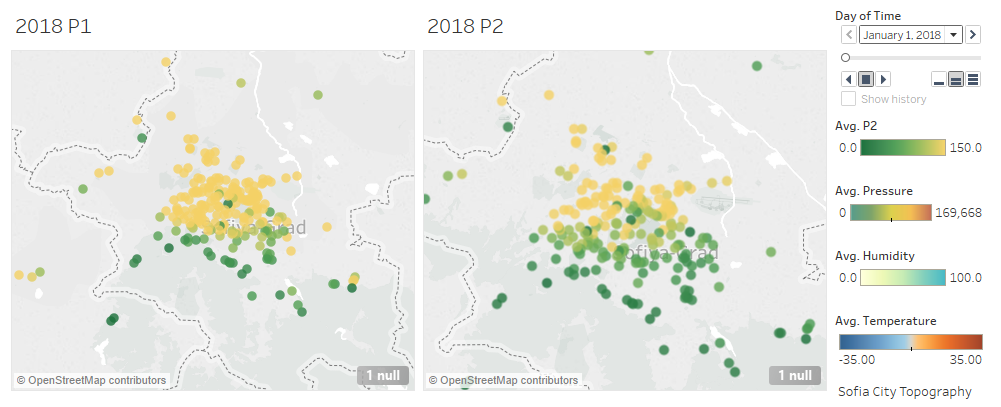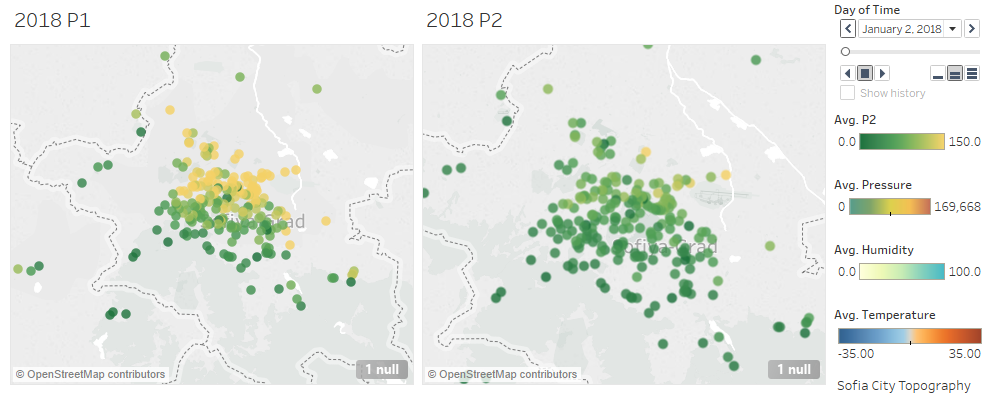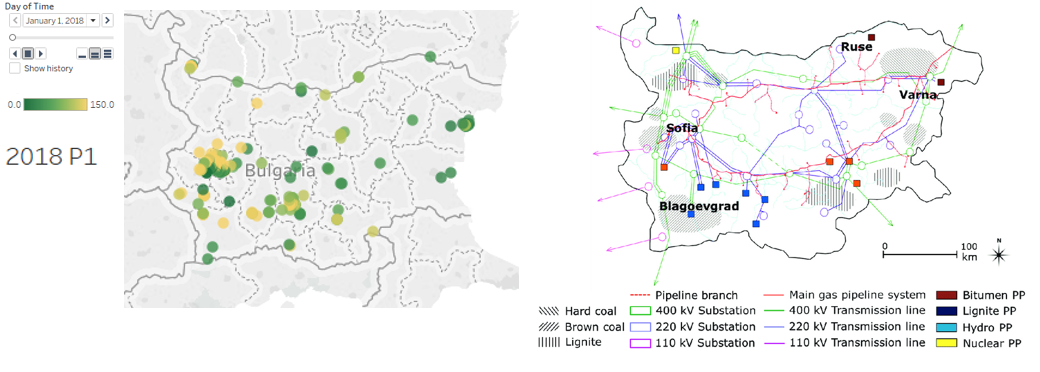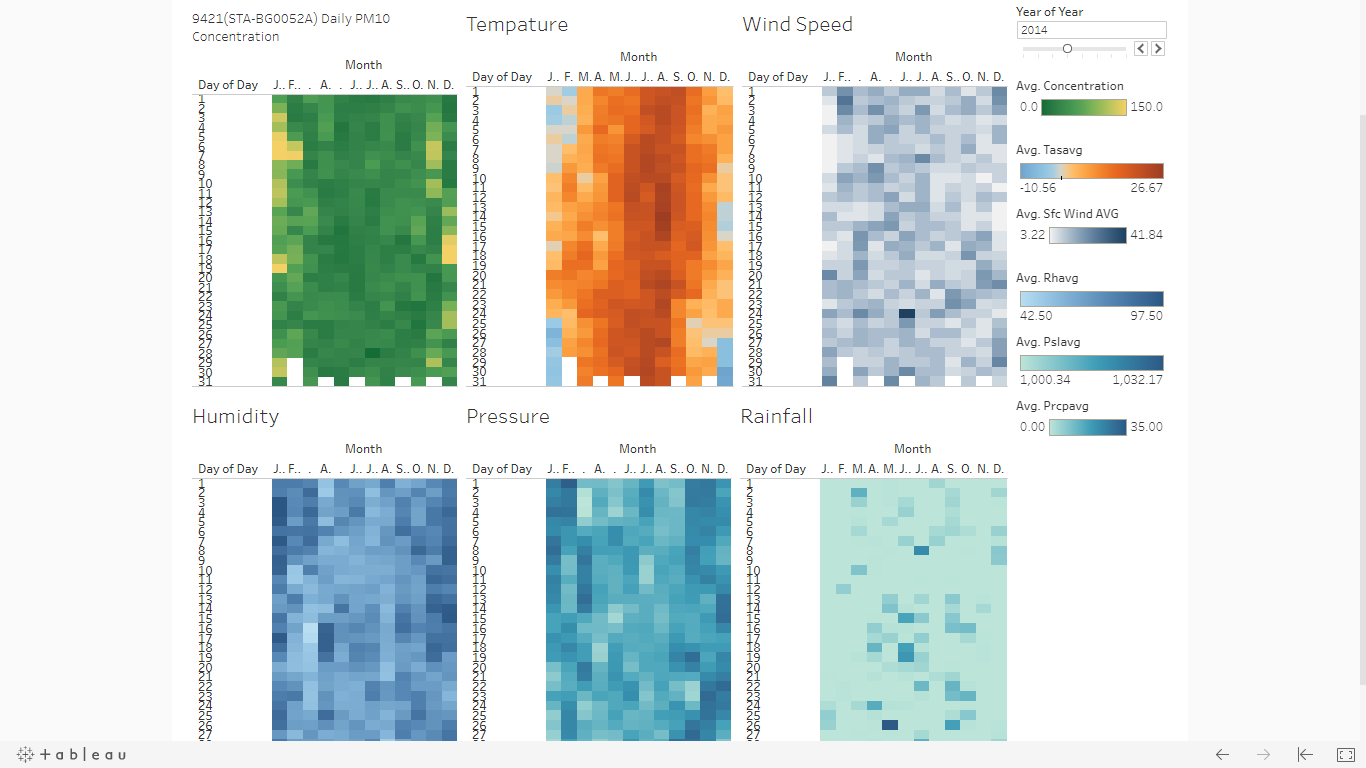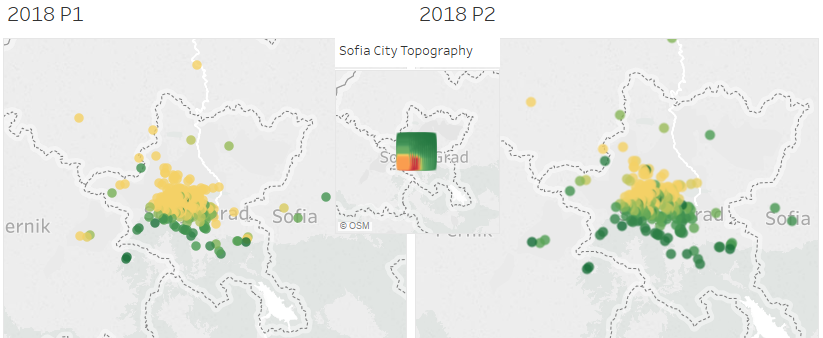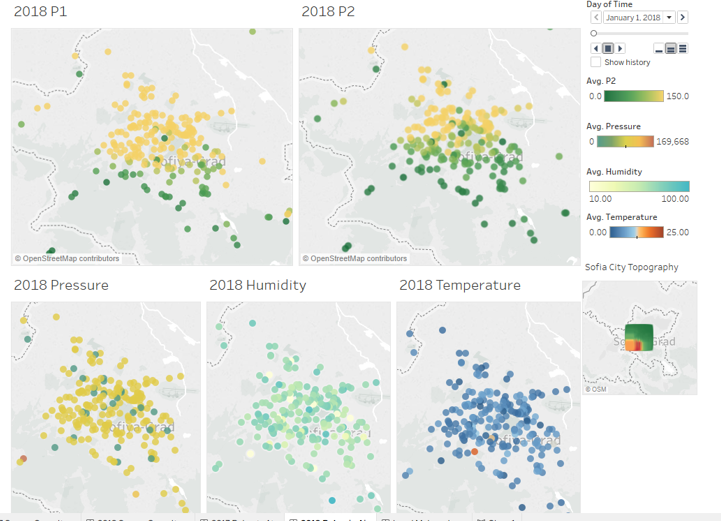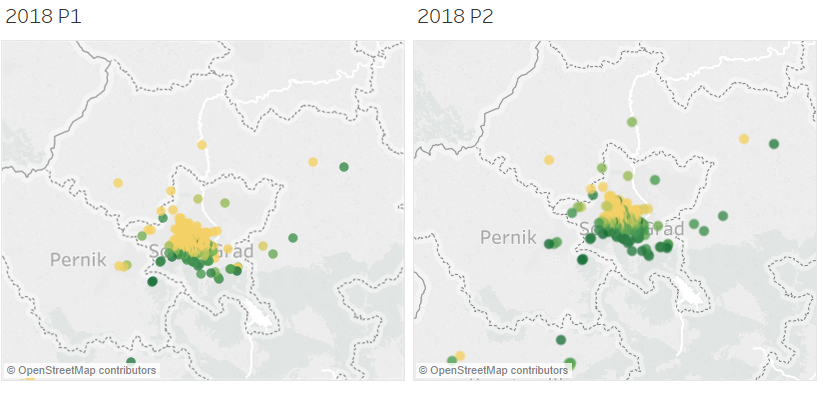Difference between revisions of "IS428 2018-19 T1 Assign Fu Yu"
Yu.fu.2015 (talk | contribs) |
Yu.fu.2015 (talk | contribs) |
||
| (30 intermediate revisions by the same user not shown) | |||
| Line 18: | Line 18: | ||
</p> | </p> | ||
| + | ===Combine multiple yearly data files into one time series data file === | ||
| + | [[File:Combine files yu.fu.2015.png|center]] | ||
=== === | === === | ||
| − | === === | + | == Dataset Import Structure & Process == |
| − | + | ===Datasets Imported to Tableau for Analysis=== | |
| + | * Air Tube datasets with geohash column being decoded | ||
| + | * EEA time series data | ||
| + | </b>[[File:Combined EEA datasets yu.fu.2015.png|left]]</br> | ||
| + | </br> | ||
| + | </br> | ||
| + | </br> | ||
| + | * EEA metadata to show station locations | ||
| + | * METEO-data | ||
| + | * TOPO-data | ||
| − | == | + | ===Join METEO-Data and Station STA-BG0052A Timeseries Data=== |
| + | With the given Meteo-data, which describes the temerature, wind speed, humidity, pressure and rainfall in Sofia Airport (42.6537, 23.3829 ), we can investigate the relationships between meteorology and air pollution. Since station STA-BG0052A(42.6665, 23.4002) is closest to Sofia Airport compared with other three stations, I use data in station STA-BG0052A for Comparison. Before visualising the two datasets, it is better to join them into one dataset. This can be done in tableau. | ||
| + | [[File:Join tables yu.fu.2015.png|center]] | ||
| + | The two datasets was joined by dates. Since the dates in the Meteo-data file are separate into year, month and day and the data types are string. Before joining them, the data types need to be changed to date. | ||
== Interactive Visualization == | == Interactive Visualization == | ||
| − | = | + | <p>The interactive visualization can be accessed here: https://public.tableau.com/profile/fu.yu#!/vizhome/AirQualityinBulgaria/Story1?publish=yes</p> |
| − | |||
| − | |||
| − | |||
| − | |||
| − | |||
| − | |||
| − | |||
| − | |||
| − | |||
| − | |||
| − | |||
| − | |||
| − | |||
| − | |||
| − | |||
| − | |||
| + | === Official Air Quality in Sofia City === | ||
| + | [[File:First-page 2 yu.fu.2015.png|500px]][[File:First-page yu.fu.2015.png|500px]] | ||
| + | <p>This dashboard shows the daily and hourly PM10 concentration in the 4 measured stations. A user can select a day on the heat map and investigate PM10 concentration at different times of the day. </p> | ||
| + | === Sensor Coverage, Performance and Operation === | ||
| + | [[File:Second page yu.fu.2015.png|500px]][[File:Second page 2 yu.fu.2015.png|500px]] | ||
| + | <p>This dashboard shows sensors and their readings in Sofia City. When selecting a sensor, the line charts will display the sensor readings at different times of the day. A user thus can tell when the sensors start not working properly.</p> | ||
| + | === Air Quality Measures in Sofia City === | ||
| + | [[File:Third page yu.fu.2015.png|500px]] | ||
| + | <p>This dashboard helps user see the flow of air pollution from day to day and analyse the impacts of local topography and meteorology on air quality.</p> | ||
| − | === | + | === Relationship between Local Meteorology and Air Pollution === |
| + | [[File:4th page yu.fu.2015.png|500px]] | ||
| + | <p>The last dashboard helps user find the relationship between local meteorology and air pollution. A user can select a few days and compare the patterns among temperature, pressure, rainfall, humidity, wind and air quality.</p> | ||
== Interesting & Anomalous Observations == | == Interesting & Anomalous Observations == | ||
| Line 82: | Line 91: | ||
|} | |} | ||
| − | === | + | === Task 2: Spatio-temporal Analysis of Citizen Science Air Quality Measurements === |
| + | {| class="wikitable" style="background-color:#FFFFFF;" width="100%" | ||
| + | |'''2.1 Sensor Coverage, Performance and Operation | ||
| + | ''' | ||
| + | * 2.1.1 Sensor Coverage | ||
| + | [[File:Sofia Sensor Coverage yu.fu.2015.png|center]] | ||
| + | The most recent sensor distribution (on 7 April 2018) shows that the sensors are not evenly spread out across the entire city. They are saturated in the center of the city. Nevertheless, the sensors did cover the central part of the city well. | ||
| + | * 2.1.2 Sensor Performance and Operation | ||
| + | [[File:Abnormal sensor 42.625x23.321 yu.fu.2015.png|center]] | ||
| + | However, the sensors were not always working properly. As shown in the graphs above, fora example, on 3 February 2018, the sensor at (42.625, 23.321) was working properly. Its readings of pressure, humidity and temperature fluctuate within reasonable ranges though the day. | ||
| + | [[File:Abnormal sensor 42.625x23.321 4Feb yu.fu.2015.png|center]] | ||
| + | However, on 4 February 2018, the sensor temperature reading had a sharp drop from 7 degree to -139 degree at 9AM, which is not reasonable. At the same time, pressure and humidity readings also increased sharply, suggesting that the sensor might have a problem on 9AM, 4 February 2018. | ||
| + | [[File:Abnormal sensor 42.625x23.321 5Feb yu.fu.2015.png|center]] | ||
| + | The suspect was approved by the static sensor readings on 5 February 2018, suggesting that the sensor was not working. | ||
| + | Similar sensor behaviors can also be seen on other sensors such as the sensor located at (42.686, 23.347) after 14 February 2018 and the sensor located at (42.715, 23.161) after 7 February 2018. | ||
| + | |} | ||
| + | {| class="wikitable" style="background-color:#FFFFFF;" width="100%" | ||
| + | |'''2.2 Air Pollution | ||
| + | ''' | ||
| + | Most of the time, pollution started from the northern part of the city. As time passes, the pollution can spread in different directions. | ||
| + | * Case 1: Pollution spread to the south | ||
| + | [[File:11242017 concentration yu.fu.2015.png|none]] | ||
| + | [[File:11252017 concentration yu.fu.2015.png|none]] | ||
| + | [[File:11262017 concentration yu.fu.2015.png|none]] | ||
| + | * Case 2: Pollution spread to the south first and then back to the north | ||
| + | [[File:12312017 concentration yu.fu.2015.png|none]] | ||
| + | [[File:01012018 concentration yu.fu.2015.png|none]] | ||
| + | [[File:01022018 concentration yu.fu.2015.png|none]] | ||
| + | |||
| + | |} | ||
| − | === | + | === Task 3: Factors Affecting Air Quality in Sofia City === |
| − | + | {| class="wikitable" style="background-color:#FFFFFF;" width="100%" | |
| + | |'''Factor 1: Local Energy Sources ''' | ||
| + | [[File:Local enery source yu.fu.2015.png|center]] | ||
| + | The diagrams above shows that in cities like Sofia and Blagoevgrad, P1 concentration is relatively high. This might be because these cities are along the main gas pipeline system. Since the cities are rich in hard coal, the gas and energy generated in these cities might be from burning of hard coals, which damages the air. | ||
| + | |} | ||
| + | {| class="wikitable" style="background-color:#FFFFFF;" width="100%" | ||
| + | |'''Factor 2: Local Meteorology ''' | ||
| + | With the given Meteo-data, which describes the temperature, wind speed, humidity, pressure and rainfall in Sofia Airport (42.6537, 23.3829 ), we can investigate the relationships between meteorology and air pollution. Since station STA-BG0052A(42.6665, 23.4002) is closest to Sofia Airport compared with other three stations, I use data in station STA-BG0052A for comparison. | ||
| + | [[File:Local meteorology and air quality yu.fu.2015.png|center]] | ||
| + | The diagrams above compare the patterns of temperature, wind speed, humidity, pressure and rainfall in Sofia Airport (42.6537, 23.3829 ) with the pattern of PM10 concentration in Station STA-BG0052A(42.6665, 23.4002) in 2014. It shows that PM10 concentration tends to be high in a low temperature, low wind speed, high humidity and high pressure environment. However, the relationship between rainfall and PM10 concentration is not very obvious. Data in 2016 also shows the same findings. | ||
| + | |} | ||
| + | {| class="wikitable" style="background-color:#FFFFFF;" width="100%" | ||
| + | |'''Factor 3: Local Topography ''' | ||
| + | [[File:Local topography and air quality yu.fu.2015.png|center]] | ||
| + | As mentioned in Task 2, pollution usually starts from the northern part of Sofia city. This may be due to the fact that Sofia's altitude is low in the north and high in the southwest. PM10 particles from the north can flow into Sofia city much more easily than those from the southwest. | ||
| + | |} | ||
| + | {| class="wikitable" style="background-color:#FFFFFF;" width="100%" | ||
| + | |'''Factor 4: Complex interactions between local topography and meteorological characteristics ''' | ||
| + | [[File:Local topography and meteorology and air quality yu.fu.2015.png|center]] | ||
| + | The diagram shows that even though the pressure was high, humidity was high and temperature was low across the city, the pollution level is high in the northern part of the city mainly because of the low altitude in the northern part. | ||
| + | |} | ||
| + | {| class="wikitable" style="background-color:#FFFFFF;" width="100%" | ||
| + | |'''Factor 5: Transboundary Pollution ''' | ||
| + | Pollution does spread from one place to another as discussed in Task 2. The graph below also displays that when air quality in Sofia is poor, the cities around it also have places with poor air quality. | ||
| + | [[File:Transboundary yu.fu.2015.png|center]] | ||
| + | |} | ||
== References == | == References == | ||
| + | <p>Understanding Particulate Matter and How It Impacts Our Health https://www.airveda.com/blog/Understanding-Particulate-Matter-and-Its-Associated-Health-Impact</p> | ||
| + | <p>Map on the Bulgarian Coal Resources and Energy Infrastructure https://www.researchgate.net/figure/Map-on-the-Bulgarian-coal-resources-energy-infrastructure-and-largest-power-plants_fig1_257941554</p> | ||
Latest revision as of 23:13, 11 November 2018
Contents
Problem & Motivation
Air pollution is an important risk factor for health in Europe and worldwide. A recent review of the global burden of disease showed that it is one of the top ten risk factors for health globally. Worldwide an estimated 7 million people died prematurely because of pollution; in the European Union (EU) 400,000 people suffer a premature death. The Organisation for Economic Cooperation and Development (OECD) predicts that in 2050 outdoor air pollution will be the top cause of environmentally related deaths worldwide. In addition, air pollution has also been classified as the leading environmental cause of cancer.
Air quality in Bulgaria is a big concern: measurements show that citizens all over the country breathe in air that is considered harmful to health. For example, concentrations of PM2.5 and PM10 are much higher than what the EU and the World Health Organization (WHO) have set to protect health.
Bulgaria had the highest PM2.5 concentrations of all EU-28 member states in urban areas over a three-year average. For PM10, Bulgaria is also leading on the top polluted countries with 77 μg/m3on the daily mean concentration (EU limit value is 50 μg/m3).
According to the WHO, 60 percent of the urban population in Bulgaria is exposed to dangerous (unhealthy) levels of particulate matter (PM10).
Dataset Analysis & Transformation Process
Decode the geohash column in Air Tube data files
Geohash tells the station locations. However Tableau is not able to interpret geohash as geographic data. Before Air Tube data is imported to Tableau for analysis, geohash needs to be decoded into geographical coordinates. As the two Air Tube data files- data_bg_2017.xlsx and data_bg_2018.xlsx are of big sizes and there are duplicate geohash records in the data, an Excel file containing a unique geohash list was created.
Step 1: Use "pygeohash" package to decode the geohash list and output the coordinates in an Excel file
Step 2: Combine geohash list and coordinates list into one Excel file and update the coordinates, latitude, longitude in data_bg_2017.xlsx and data_bg_2018.xlsx using VLOOKUP, LEFT and RIGHT functions in Excel
Combine multiple yearly data files into one time series data file
Dataset Import Structure & Process
Datasets Imported to Tableau for Analysis
- Air Tube datasets with geohash column being decoded
- EEA time series data
- EEA metadata to show station locations
- METEO-data
- TOPO-data
Join METEO-Data and Station STA-BG0052A Timeseries Data
With the given Meteo-data, which describes the temerature, wind speed, humidity, pressure and rainfall in Sofia Airport (42.6537, 23.3829 ), we can investigate the relationships between meteorology and air pollution. Since station STA-BG0052A(42.6665, 23.4002) is closest to Sofia Airport compared with other three stations, I use data in station STA-BG0052A for Comparison. Before visualising the two datasets, it is better to join them into one dataset. This can be done in tableau.
The two datasets was joined by dates. Since the dates in the Meteo-data file are separate into year, month and day and the data types are string. Before joining them, the data types need to be changed to date.
Interactive Visualization
The interactive visualization can be accessed here: https://public.tableau.com/profile/fu.yu#!/vizhome/AirQualityinBulgaria/Story1?publish=yes
Official Air Quality in Sofia City
This dashboard shows the daily and hourly PM10 concentration in the 4 measured stations. A user can select a day on the heat map and investigate PM10 concentration at different times of the day.
Sensor Coverage, Performance and Operation
This dashboard shows sensors and their readings in Sofia City. When selecting a sensor, the line charts will display the sensor readings at different times of the day. A user thus can tell when the sensors start not working properly.
Air Quality Measures in Sofia City
This dashboard helps user see the flow of air pollution from day to day and analyse the impacts of local topography and meteorology on air quality.
Relationship between Local Meteorology and Air Pollution
The last dashboard helps user find the relationship between local meteorology and air pollution. A user can select a few days and compare the patterns among temperature, pressure, rainfall, humidity, wind and air quality.
Interesting & Anomalous Observations
Task 1: Spatio-temporal Analysis of Official Air Quality
| 1.2 A Typical Day in Sofia City
To investigate how PM10 concentrations vary from hours to hours in a day, one can simply highlight a day on the heatmap and the hourly PM10 concentration graphs will update accordingly. For example, as shown in the diagram above, on 8 January 2018, air quality in stations STA-BG0052A and STA-BG0050A is poor after 10pm while air quality in station STA-BG0073A is poor starting from 12pm and in STA-BG0040A, air quality is poor throughout the day. Trends:
|
| 1.3 Anomalies in the Datesetss
|
Task 2: Spatio-temporal Analysis of Citizen Science Air Quality Measurements
| 2.1 Sensor Coverage, Performance and Operation
The most recent sensor distribution (on 7 April 2018) shows that the sensors are not evenly spread out across the entire city. They are saturated in the center of the city. Nevertheless, the sensors did cover the central part of the city well.
However, the sensors were not always working properly. As shown in the graphs above, fora example, on 3 February 2018, the sensor at (42.625, 23.321) was working properly. Its readings of pressure, humidity and temperature fluctuate within reasonable ranges though the day. However, on 4 February 2018, the sensor temperature reading had a sharp drop from 7 degree to -139 degree at 9AM, which is not reasonable. At the same time, pressure and humidity readings also increased sharply, suggesting that the sensor might have a problem on 9AM, 4 February 2018. The suspect was approved by the static sensor readings on 5 February 2018, suggesting that the sensor was not working. Similar sensor behaviors can also be seen on other sensors such as the sensor located at (42.686, 23.347) after 14 February 2018 and the sensor located at (42.715, 23.161) after 7 February 2018. |
| 2.2 Air Pollution
Most of the time, pollution started from the northern part of the city. As time passes, the pollution can spread in different directions.
|
Task 3: Factors Affecting Air Quality in Sofia City
| Factor 1: Local Energy Sources
The diagrams above shows that in cities like Sofia and Blagoevgrad, P1 concentration is relatively high. This might be because these cities are along the main gas pipeline system. Since the cities are rich in hard coal, the gas and energy generated in these cities might be from burning of hard coals, which damages the air. |
| Factor 2: Local Meteorology
With the given Meteo-data, which describes the temperature, wind speed, humidity, pressure and rainfall in Sofia Airport (42.6537, 23.3829 ), we can investigate the relationships between meteorology and air pollution. Since station STA-BG0052A(42.6665, 23.4002) is closest to Sofia Airport compared with other three stations, I use data in station STA-BG0052A for comparison. The diagrams above compare the patterns of temperature, wind speed, humidity, pressure and rainfall in Sofia Airport (42.6537, 23.3829 ) with the pattern of PM10 concentration in Station STA-BG0052A(42.6665, 23.4002) in 2014. It shows that PM10 concentration tends to be high in a low temperature, low wind speed, high humidity and high pressure environment. However, the relationship between rainfall and PM10 concentration is not very obvious. Data in 2016 also shows the same findings. |
| Factor 3: Local Topography
As mentioned in Task 2, pollution usually starts from the northern part of Sofia city. This may be due to the fact that Sofia's altitude is low in the north and high in the southwest. PM10 particles from the north can flow into Sofia city much more easily than those from the southwest. |
| Factor 4: Complex interactions between local topography and meteorological characteristics
The diagram shows that even though the pressure was high, humidity was high and temperature was low across the city, the pollution level is high in the northern part of the city mainly because of the low altitude in the northern part. |
| Factor 5: Transboundary Pollution
Pollution does spread from one place to another as discussed in Task 2. The graph below also displays that when air quality in Sofia is poor, the cities around it also have places with poor air quality. |
References
Understanding Particulate Matter and How It Impacts Our Health https://www.airveda.com/blog/Understanding-Particulate-Matter-and-Its-Associated-Health-Impact
Map on the Bulgarian Coal Resources and Energy Infrastructure https://www.researchgate.net/figure/Map-on-the-Bulgarian-coal-resources-energy-infrastructure-and-largest-power-plants_fig1_257941554
